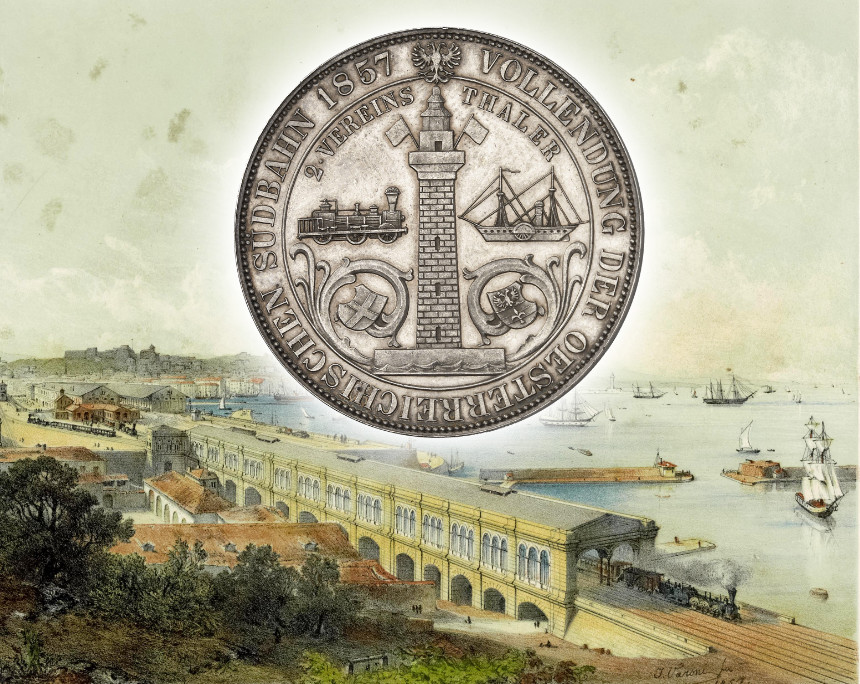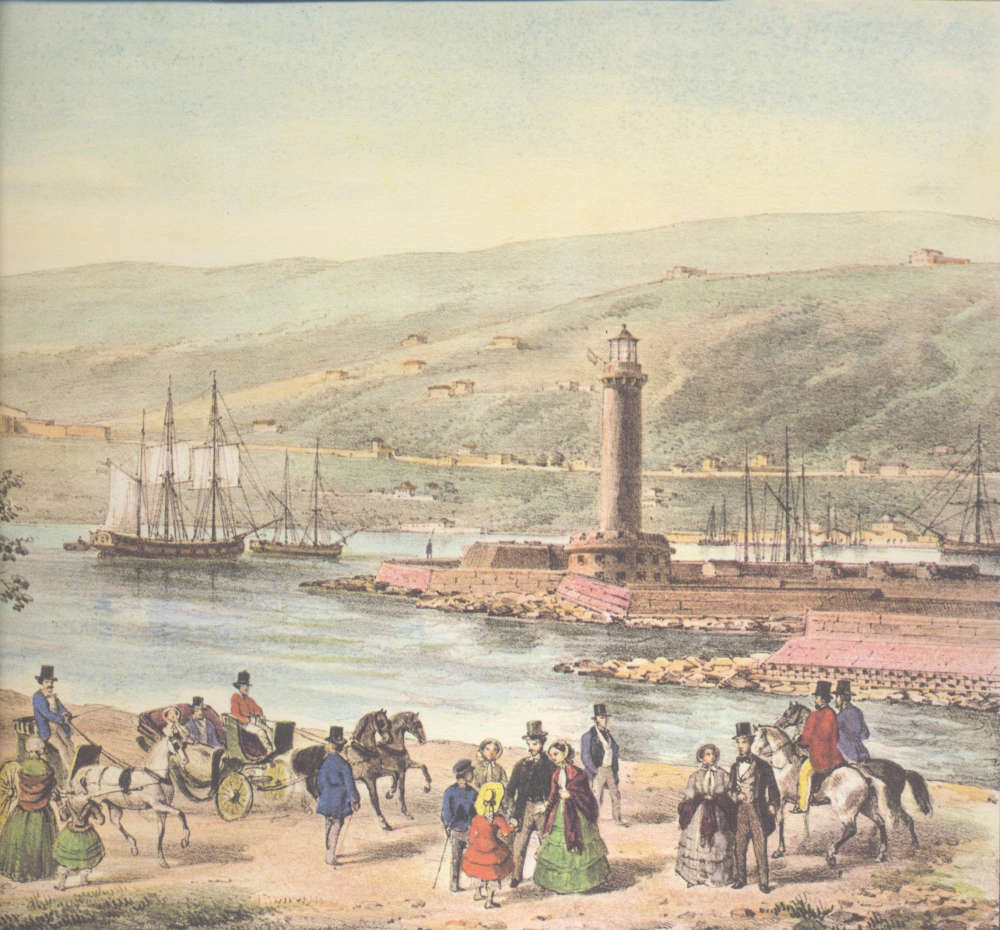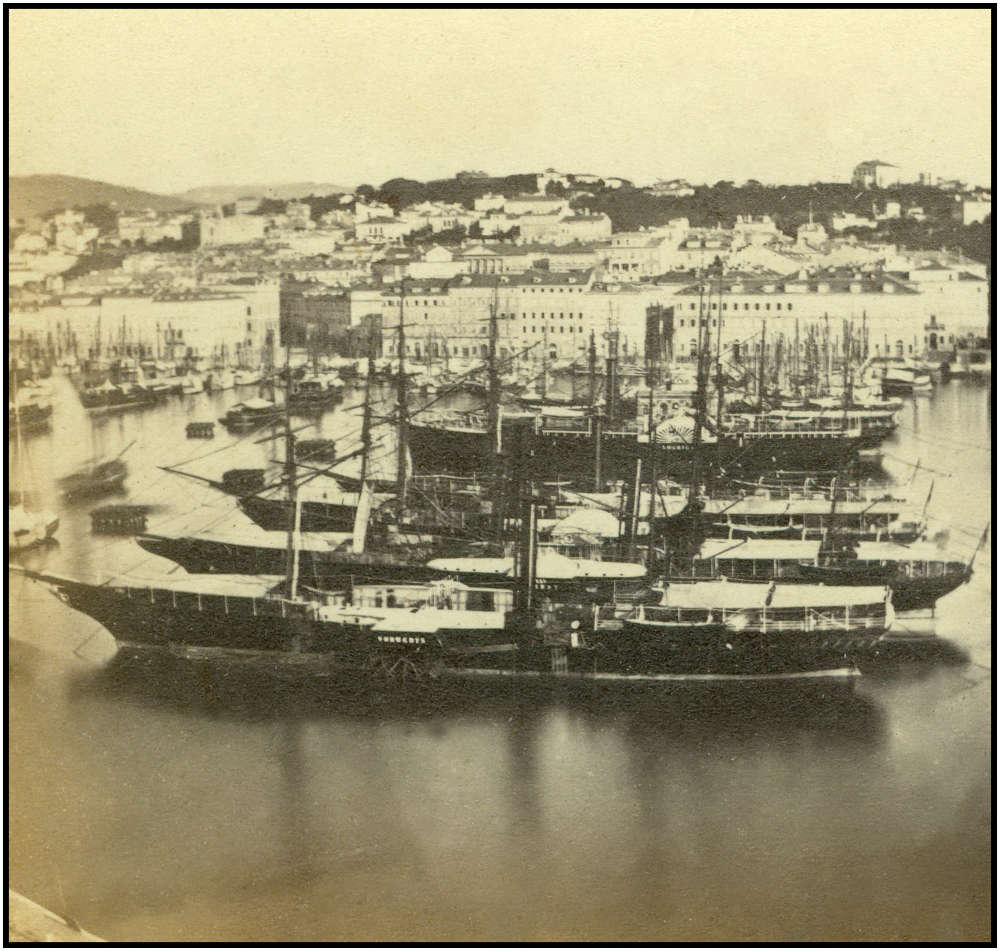A Commemorative Coin Celebrating the Completion of Austria’s Southern Railway
Commemorative coins were a rare phenomenon in the 19th century. During the first 25 years of Emperor Franz Joseph’s reign, there were only two occasions that he honored with a commemorative coin: his wedding to “Sisi” and the completion of the Austrian Southern Railway (Vollendung der Oesterreichischen Südbahn) in 1857. All the contemporaries who came to know about this commemorative coin in 1857 were well aware of how important this project was to the Habsburg empire.
Content
Therefore, this commemorative coin must not be viewed from the perspective of modern commemorative issues. While today’s coins rather focus on collectors, their needs and the profits of mints and / or the state, commemorative issues used to play an important role in official ceremonies. We want to use this specimen to illustrate their function.
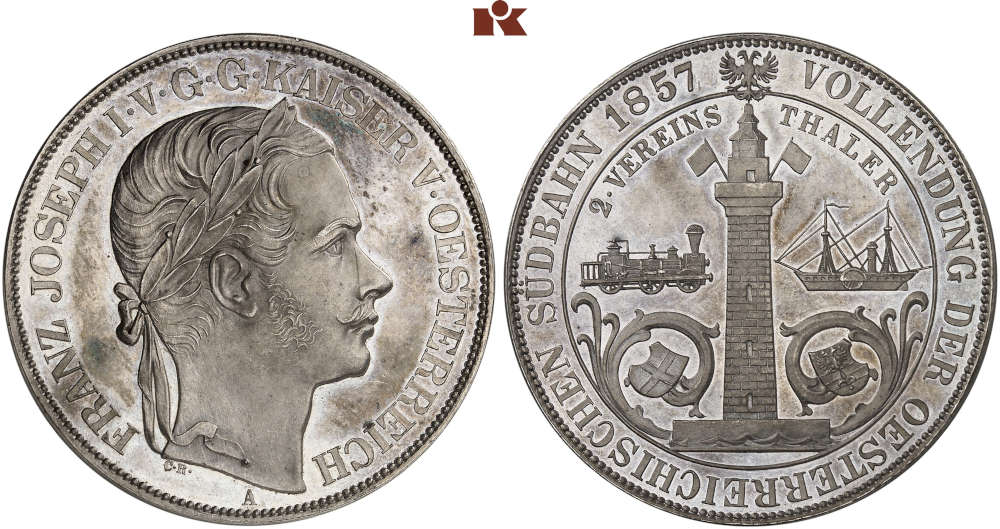
1857 double vereinstaler, Vienna Principal Mint. Only 1644 specimens minted. Showpiece struck from polished dies. About FDC. Estimate: 4,000 euros. From a Rhenish German private collection. From Künker auction 308 (18-19 June 2024), No. 470.
The Coin for the Completion of Austria’s Southern Railway
The obverse shows the Emperor’s head with laurel wreath to the right, surrounded by the circumscription Franz Joseph I by God’s Grace Emperor of Austria (Franz Joseph I. von Gottes Gnaden Kaiser von Österreich). The A indicates the Vienna Principal Mint (Wiener Hauptmünzamt). The small initials C.R. refer to the engraver Carl Radnitzky.
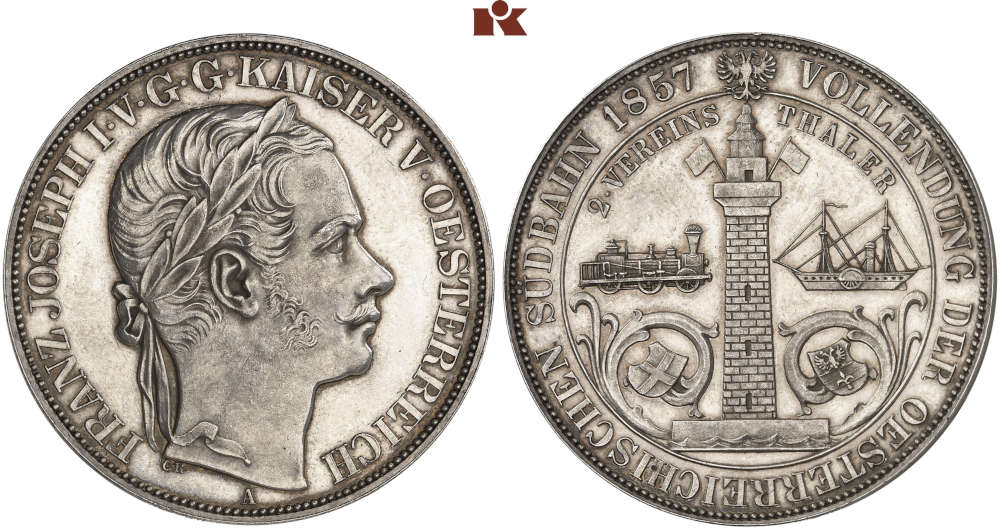
1857 double vereinstaler, Vienna Principal Mint. Only 1644 specimens minted. Showpiece struck from polished dies. About FDC. Estimate: 4,000 euros. From a Rhenish German private collection. From Künker auction 308 (18-19 June 2024), No. 471.
Today, collectors distinguish between two varieties of this commemorative coin, depending on where the top leaf of the laurel wreath points: to the K, as on the previous piece, or to the A, as on this specimen.
The reverse of both varieties is identical. We can read “2 vereinsthaler” as the denomination, i.e., the coin’s face value. The design is dominated by a lighthouse, crowned by the Habsburg double eagle. It is the lighthouse of the old harbor of Trieste, the so-called “Lantern”, which must not be confused with the Faro della Vittoria, built after the First World War.
Similarly, the top right of the design does not depict a random ship, but a paddle steamer of the type operated by Österreichischer Lloyd, the largest Austro-Hungarian shipping company. Founded in 1832, the company operated steamers on the Danube, the Po, Lake Maggiore, the Mediterranean and the Atlantic. From Trieste, Lloyd offered shipping lines along the Dalmatian coast, as well as to Greece, Turkey, the Levant and even to Egypt. Later, there were even overseas services to destinations such as Singapore and Hong Kong.
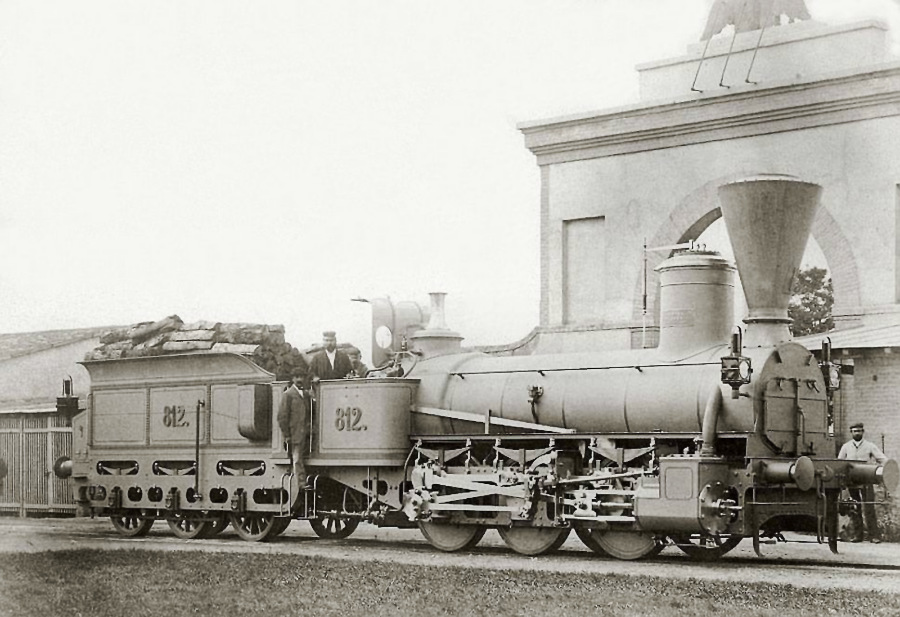
The coin probably depicts the predecessor to the SB 23 steam locomotive of the type produced by the Wiener Neustädter Lokomotivfabrik (Vienna Neustadt Locomotive Factory).
Opposite, on the left, we can see a steam locomotive, which – as Michael Autengruber kindly told us – is probably the predecessor to the SB 23 steam locomotive. Powerful locotomotives such as this one enabled heavy freight trains to negotiate the steep Alpine passes of the Semmering.
By juxtaposing the locomotive with the steamship, the coin’s design emphasizes a fact that was of enormous importance to the Austrian Empire: the Southern Railway was the direct link between the capital Vienna and the Mediterranean, and thus the wider world. The railway line greatly accelerated the movement of goods and people. The two coats of arms therefore represent Vienna (below the locomotive) and Trieste (below the steamer).
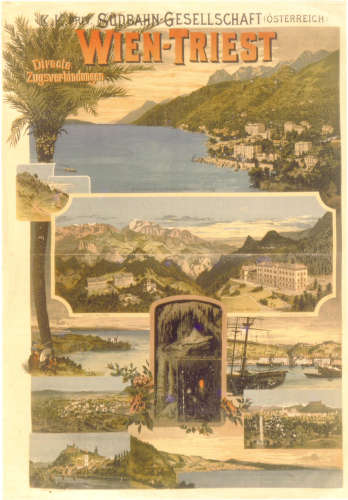
1898 poster of the Southern Railway Company, promoting the direct railway line from Vienna to Trieste.
Why Was the Austrian Southern Railway Built?
As early as in 1841, when the first section of the planned railway line was opened, the Viennese discovered that the railway offered great potential for leisure activities. And yet, tourism was the last thing on Emperor Franz Joseph’s mind when he championed the construction of the railway. The fact that almost all the lines of today’s Austrian railway network were built during his reign was largely due to trade policy. Industry throughout the Habsburg Empire benefited from safe, regular and relatively cheap transport.
But military considerations were just as important. Throughout the world, railways became the most important means of transport when troops had to be moved quickly. Since Venice had proved unreliable during the 1848 revolution, Franz Joseph was looking for an alternative. Trieste seemed the logical choice. However, there was no safe, fast connection between the Austrian mainland and the port. Such a link had to be built first. It was of utmost importance for the railway to be constructed on unassailable ground. It was therefore decided not to build the railway across the Hungarian Plain – as had been the original plan. Although this would have been much cheaper, the Magyars had also turned their backs on the Habsburgs in 1848. This is why the Austrian government opted to lay the railway across the Alps. The result was an engineering masterpiece. The Semmering Railway – now a UNESCO World Heritage Site – is rightly regarded as a milestone in railway history.
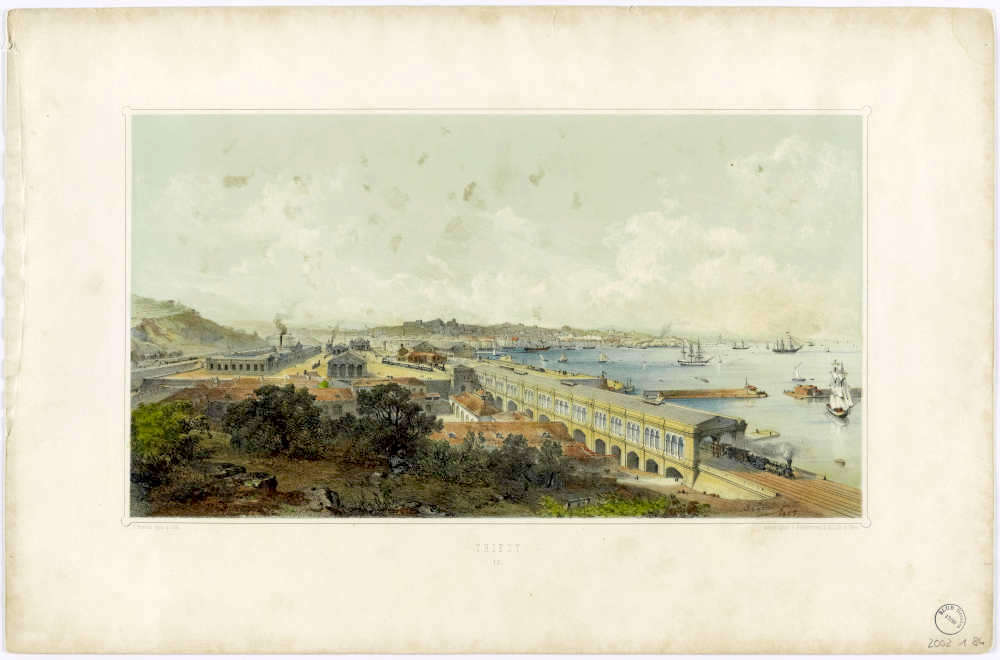
The last viaduct before entering the Trieste railway station. From the album: Zur Erinnerung an die Eröffnung der Staats-Eisenbahn von Laibach bis Triest unter den Allerhöchsten Auspicien Seiner k. k. apost. Majestät des Kaiser Franz Joseph I. von 1857. SLUB Dresden. Public Domain Mark 1.0. PPN 337170053.
The Last Stone and the Ceremonial Opening of the Railway Line
On 27 July 1857, the last section of the new line between Ljubljana and Trieste was inaugurated in a ceremony attended by the Emperor himself. The Wiener Zeitung (Vienna Newspaper) of 29 July 1857 reported on the festivities. The celebrations took place in Trieste, or rather near the last viaduct that the train passed before entering the railway station. It was here that Emperor Franz Joseph was to lay the last stone of the construction.
The Wiener Zeitung reported on the magnificent atmosphere: “Where only a few weeks ago everything was in chaotic disarray, and one had the feeling of being in a quarry rather than on a building site, a garden has been conjured up. More than a thousand fir trees, all sorts of native and exotic plants, fountains and elegant pavilions form a graceful park, which is all the more surprising when you consider how quickly this creation has been brought to life. … The paths from the imperial pavilion to the site of the viaduct, where His Majesty the Emperor performed the ceremonial laying of the last stone, were covered with fine cloths and carpets, and graceful and comfortable steps led to the opening into which the last stone was laid.”
The Emperor and a large delegation of government and trade representatives travelled by train from Vienna. The journey must have taken a long time, for no town or city failed to give the monarch a proper welcome on his arrival: “The stations along the entire length of the Southern Railway were festively decorated, and the authorities, clergy and so on awaited the imperial train to greet the monarch with reverence.”
A large crowd had also gathered in Trieste: “The crowds gathered on tastefully decorated and spacious stands, protected from the sun by canvas roofs, and looked forward with eager anticipation to the approach of the imperial train.”
The steamships of Österreichischer Lloyd accompanied the train for the last few kilometers: “The lavishly dressed steamers, which Österreichischer Lloyd had positioned along the coast from St. Bartholomew to below Santa Croce, set off as soon as the imperial train emerged from the rocks below Nabresina and accompanied it to the station.”
Their guns announced to the waiting crowd that the Emperor was about to arrive: “At last, gun salutes heralded that he was moving from Nabresina towards the city; at 10.15 the train entered the station, greeted by the roar of the national anthem, the thunder of the artillery batteries of the harbor and the forts, and thousands of cheers.”
After the official welcome by the city’s dignitaries, Franz Joseph gave a speech before laying the last stone. He said: “It is with the highest satisfaction that I lay the last stone of a work which, after overcoming the greatest difficulties, is now complete and which I hope, with God’s help, is destined to increase the prosperity of the provinces of my Empire, and especially those of my most faithful city, Trieste, upon which I invoke the blessing of the Almighty.”
Only then was the final stone laid. Franz Joseph walled a copper box into an open niche in the viaduct, and it is in this context that we learn of the role that commemorative coins played in this ceremony. In addition to a number of objects, the copper box contained “a commemorative coin minted to recall these festivities, and several circulation coins”.
This was followed by the Te Deum, the Bishop’s blessing and then the Emperor entered the city, where a further ceremony was held at the palace.
Who Received the Commemorative Coins to Mark the Completion of the Southern Railway?
Unfortunately, contemporary newspaper reports reveal little about who received the 1,644 commemorative coins minted to celebrate the completion of the Southern Railway. However, we can assume that the procedure regarding these pieces, which were not primarily intended for circulation given the low mintage number, was similar to that of medals. In 2023, Andrea Mayr published a ground-breaking work on the ceremonial use of this medium, showing that medals were primarily given to “a representative public”. In other words: it is likely that Franz Joseph, or a member of his entourage on his behalf, presented the dignitaries who had travelled to the ceremony with a commemorative coin in an elaborate case. Coins that were not used could be bought at a surcharge at the counter of the Vienna Principal Mint after the festivities, which is why collectors could – if they were lucky – obtain such a coin.







